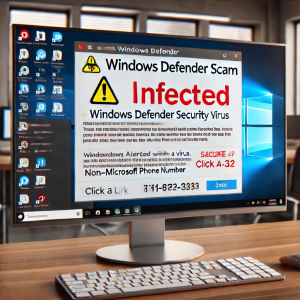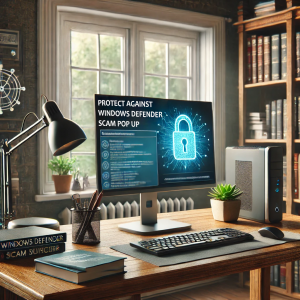Windows Defender Security Scam Pop up
In recent years, the digital landscape has seen an unprecedented rise in cybersecurity threats, posing significant risks to individuals and organizations alike. Among these threats, scams involving Windows Defender security warnings have become particularly prevalent. Scammers craft deceptive messages that mimic legitimate Windows security alerts, exploiting the trust that users have in Microsoft’s built-in security system.
Recognizing these fraudulent messages is crucial for protecting your personal information and maintaining the integrity of your systems. These scam messages, often appearing as Windows Defender scam pop-ups or fake Windows Defender security warnings, can cause severe consequences such as data theft, financial loss, and illegal access to personal accounts.
The purpose of this blog is to inform readers about the significance of identifying and responding appropriately to these deceptive Windows Defender security scam pop ups. By understanding what to look for in a genuine Microsoft Windows security alert and distinguishing it from a Windows Defender security warning scam, you can better safeguard your digital life against these malicious attempts.
Through detailed insights and expert advice, we will explore the various forms these scams take, how they function, and the steps you can take to secure yourself. Whether it’s a suspicious Windows Defender security alert or a more insidious fake Windows Defender security warning, being informed is your first line of defense in the evolving battle against cyber threats.
Understanding Windows Defender Security Scam Messages
Windows Defender is a strong built-in security feature of the Windows operating system designed to protect users against malware, spyware, and other malicious software. It offers real-time protection, a firewall, and performance tuning among other functionalities to safeguard computers from external threats. Understanding its legitimate functions is crucial to discerning when you’re faced with a Windows Defender security warning pop up that’s authentic versus one that’s part of a scam.
Windows Defender security scams often masked as legitimate security alerts to deceive users. These fake Windows Defender security warnings are crafted with alarming precision, sometimes replicating the look and feel of genuine Windows security notifications. However, unlike the real alerts that aim to protect your system, these scam messages attempt to provoke a sense of urgency, pushing you to make hasty decisions that could compromise your security.
Common features of these scam messages include:
- Urgent language that warns of an immediate threat to your system, pressuring you to act quickly.
- Requests for personal information, such as passwords or bank details, which legitimate security programs would never solicit via pop-up alerts.
- Links that direct to non-Microsoft sites or unfamiliar web pages where you are asked to enter personal information or download software that is supposedly needed to address security threats.
Recognizing these signs is key to identifying bogus Windows security alerts. Additionally, Windows Defender scam pop ups might claim that your PC is infected with a trojan or spyware, presenting a button or link to ‘fix’ the issue. Clicking on these can lead to real security threats, such as ransomware or phishing software being installed on your machine.
The Windows Defender security warning scam can also appear in various forms such as email attachments or fraudulent customer support numbers. It is essential to scrutinize every alert and message that claims to be from Windows Defender, especially if it exhibits any of the common scam characteristics like those mentioned above. If you encounter a fake Windows security alert, it is advised to take no action on the pop-up itself and verify its authenticity through proper channels.
Common Types of Windows Defender Security Scams
Windows Defender scams take various forms, each designed to exploit the trust users place in Microsoft’s security products. Recognizing the different types can help you avoid falling victim to these deceitful tactics.
-
Email Scams:
These scams often come in the form of email alerts that appear to be from Microsoft. They include fake Windows Defender security warnings claiming that your system has been compromised or that urgent action is required to protect your data. These emails may have logos, signatures, and formatting that look remarkably legitimate. However, they typically aim to trick you into providing personal information or clicking on illicit links that install malware. Look out for warning signs like poor grammar, unsolicited requests for personal information, or email addresses that do not align with the official Microsoft domain.
-
Pop-Up Warnings on Websites:
Windows Defender scam pop ups can appear while browsing the internet, falsely informing you that your computer is infected with a virus. These pop-up scams often create a sense of urgency, prompting you to download software that is actually malware or to visit a compromised site to ‘clear’ the infection. Authentic Windows Defender alerts will never appear as pop-ups in your web browser but will instead be displayed directly within the security dashboard of your operating system.
-
Phone Calls from Fake Microsoft Tech Support:
Another prevalent scam involves phone calls from individuals claiming to be Microsoft support technicians. In these cases, the scammers may refer to non-existent Windows security alerts or offer to resolve issues that your computer supposedly has. They often request remote access to your computer, which can lead to data theft or ransomware being installed. It’s important to remember that Microsoft does not make unauthorized phone calls to request personal or financial information or to offer tech support.
By understanding these common types of Windows Defender scams, you can better protect yourself from the threats posed by cybercriminals looking to exploit the credibility of trusted security systems like Windows Defender. Always verify the authenticity of any security message you receive and use official channels to contact support services if in doubt.
How to Verify the Authenticity of Windows Defender Alerts
In an age where Windows Defender security scams are increasingly sophisticated, verifying the authenticity of security alerts is crucial. Scammers adeptly mimic the appearance and tone of legitimate alerts, making it difficult to distinguish the real from the fake. Below, we provide essential steps and tips to ensure that any Windows Defender alert you receive is genuinely from Microsoft.
Checking the Source of the Message
-
Email Verification:
Always scrutinize the sender’s email address. Official Microsoft Defender alerts come from email addresses with a domain that ends in “@microsoft.com”. Beware of email addresses that attempt to mimic this, such as “@microsoft-security.com” or other variations that include additional terms or misspellings.
-
URL Examination:
Hover over any links in the message without clicking them to see where they lead. A genuine Microsoft Windows Defender alert will direct you to a site that belongs to the “microsoft.com” domain. Be cautious of URLs that are misspelled or use misleading domain names.
-
Phone Number Authenticity:
If you receive a phone call claiming to be from Microsoft support following a Windows Defender security warning, hang up. Microsoft does not make unauthorized calls to help fix your computer. Any such call is a scam.
Using Official Microsoft Resources for Verification
-
Microsoft Security Dashboard:
Access your Windows security settings directly through your control panel or system settings. Genuine Windows Defender security warnings will be displayed here if they are legitimate.
-
Microsoft Support Website:
Visit the official Microsoft website for guidance and support. If you receive a Windows Defender security warning scam message or a fake Windows Defender security warning, you can compare it with the information on the official site or contact Microsoft support through their official channels.
-
Security Software Status:
Regularly check the status of your Windows Defender or other security software installed on your computer. An active and up-to-date antivirus program will provide real-time protection and display notifications directly within the software, not through web browsers or pop-ups.
Importance of Regular Windows Updates
Make sure that your Windows operating system and all security software are regularly updated. Updates frequently contain fixes for security flaws that scammers might exploit to send fake alerts. Keeping your software up to date is an essential step in protecting yourself from Windows Defender scam pop ups.
By applying these practices into your routine, you can significantly enhance your ability to distinguish legitimate Windows Defender security warnings from scams. Always err on the side of caution and use verified and direct channels to communicate with Microsoft or any other service provider. Remember, staying informed and vigilant is your best defense against cyber threats.
Immediate Steps to Take When Facing a Windows Defender Scam Message
When you encounter what seems to be a Windows Defender scam pop up or receive any form of fake Windows Defender security warning, it’s critical to act quickly and cautiously. Below are steps to ensure you do not fall prey to such scams and to maintain the security of your personal information and devices.
Avoid Interacting with the Scam pop up
-
Do Not Click on Any Links:
This is crucial if you receive a Windows security alert pop up or an email with a suspicious link. Clicking on these links can cause malicious software being downloaded onto your device, further compromising your security.
-
Do Not Provide Personal Information:
Scams often aim to collect sensitive information. Any request for personal details through a supposed Windows Defender security warning should be considered a red flag.
How to Report the Scam to Microsoft
-
Use Microsoft’s Official Channels:
Reporting these incidents helps improve security for all users. If you encounter a fake Windows security alert, you can report it directly to Microsoft through their official website. This helps them track scam trends and potentially warn other users.
-
Document the Scam:
If possible, take screenshots of the Windows Defender security scam pop up or save emails without clicking on any embedded links. This documentation can be handy when reporting the scam.
Secure Your Account and Device
-
Run a Security Scan:
Use your legitimate security software to run a full scan. This can help detect and remove Windows Defender security warnings that are malicious or any malware that might have been installed.
-
Change Your Passwords:
If you suspect that your information might have been compromised, change your passwords immediately. This is important particularly for sensitive accounts like email, banking, or social media.
-
Update Your Security Software:
Make sure your antivirus and anti-malware software are updated to protect from the latest threats. Regular updates can prevent future scams and block new malware variants.
-
Enable Two-Factor Authentication (2FA):
For added security, enable 2FA on all accounts that support it. This provides an additional layer of security beyond just your password, making unauthorized access more difficult.
Additional Precautions
-
Educate yourself and others:
Awareness is a powerful tool in combating scams. Educate yourself about the latest scam tactics like Windows fake virus warnings and Windows spyware alerts. Share this knowledge with friends and family to prevent them from falling victim to same kinds of scams.
-
Review Account Activity:
Regularly check your account activity for any unauthorized actions. If you see anything suspicious, take immediate steps to secure your account and report it to the service provider.
By taking these immediate actions after suspecting a Windows Defender security scam pop up, you can help to decrease the risk of further damage and protect your digital environment from these increasingly sophisticated cyber threats.
Preventive Measures to Protect against Windows Defender Scam Pop up
 Safeguarding against Windows Defender security scams requires proactive and ongoing measures. By staying vigilant and implementing strong security practices, you can significantly reduce the possibility of falling victim to these threats. Here are essential preventive measures to keep your devices and personal information secure.
Safeguarding against Windows Defender security scams requires proactive and ongoing measures. By staying vigilant and implementing strong security practices, you can significantly reduce the possibility of falling victim to these threats. Here are essential preventive measures to keep your devices and personal information secure.
Regular Updates of Windows Defender and Other Security Software
-
Stay Updated:
Regularly update your Windows Defender, especially if you’re using Windows 10, as each update often includes security enhancements and vulnerability patches. These updates are crucial in protecting against the latest Windows Defender Trojan alerts and other malware threats.
-
Use Reliable Security Software:
Apart from Windows Defender, consider using additional reputable anti-malware and antivirus software. This layered security approach helps detect and prevent threats that might bypass a single security measure.
Educating Oneself about the Latest Phishing and Scam Tactics
-
Stay Informed:
Cyber threats evolve rapidly. Regularly educating yourself about the latest phishing techniques and Windows scam alerts can prepare you to better recognize and avoid them. Subscribe to security newsletters, attend webinars, and follow trusted cybersecurity experts on social media.
-
Recognize Scam Indicators:
Learn the common characteristics of scam messages, such as fake Windows Defender security warnings or Windows security alerts that push you to act urgently or request sensitive information. Knowing what a legitimate alert should look like can help you spot inconsistencies in scam attempts.
Using Robust, Unique Passwords and Enabling Two-Factor Authentication
-
Strong, Unique Passwords:
Use complicated passwords that include a combination of letters, numbers, and symbols. Avoid using the same password across multiple sites to limit the damage if one account is compromised. Tools like password managers can help generate and store strong passwords securely.
-
Two-Factor Authentication (2FA):
Enable 2FA on all accounts that offer it. This adds an extra degree of securtiy by requiring another form of verification (like a text message or authentication app) to access your account, which can prevent illegal access even if your password is compromised.
Additional Tips
-
Backup your Data:
Regularly back up important data to an external drive or cloud service. This ensures that you can restore your information if it’s lost or compromised due to a Windows Defender security warning scam pop up.
-
Use Safe Networks:
Avoid using public Wi-Fi for transactions or accessing sensitive information. Use a VPN for enhanced security when connecting to public networks.
By adopting these preventive measures, you can significantly fortify your defenses against Windows Defender scam pop ups and other cyber threats. Staying updated, educated, and vigilant are key strategies in ensuring your digital safety in an increasingly connected world.
FAQs
Q1. What is a Windows Defender security scam?
- A. Windows Defender security scam involves fake alerts that mimic legitimate Windows security alerts to deceive users. These can include fake Windows Defender security warnings, email scams, and deceptive pop-ups designed to steal personal information or infect your device with malware.
Q2. How can I identify a fake Windows Defender security warning?
- A. You can identify a fake Windows Defender security warning by checking for urgency in the message, requests for personal information, and links directing to non-Microsoft sites. Legitimate Windows Defender alerts will not ask for personal details or direct you to external websites.
Q3. What should I do if I receive a Windows Defender scam pop-up?
- A. If you encounter a Windows Defender scam pop up, do not click on any links or provide any personal information. Instead, close the window and report the incident to Microsoft through their official support channels.
Q4. Are Windows Defender security warnings in emails always scams?
- A. Not all emails with Windows Defender security warnings are scams, but it’s crucial to verify the sender’s email address and look for official Microsoft domains. Always cross-check any Microsoft windows defender security warnings with your actual security software status.
Q5. Can Windows Defender itself alert me to a Trojan or spyware threat effectively?
- A. Yes, Windows Defender can effectively alert you to Trojan and spyware threats through its real-time protection features. Ensure that your Windows Defender Trojan alerts and other notifications are enabled and that the software is up to date.
Q6. What is a Windows security alert pop up and how is it different from a scam?
- A. A legitimate Windows security alert pop up comes directly from your system’s security software, specifically alerting you to security threats without asking for personal information. A scam, however, may mimic this pop-up, urging immediate action like downloading software or providing personal info.
Q7. How can I safely remove a fake Windows Defender security warning from my computer?
- A. To safely remove a fake Windows Defender security warning, run a full system scan using your legitimate antivirus software to identify and eliminate any malware. Avoid interacting with the scam message itself.
Q8. What are the signs of a bogus Windows security alert?
- A. Signs of a bogus Windows security alert include grammatical errors, urgent requests for action, suspicious sender addresses, and links that do not lead to genuine Microsoft websites.
Q9. Why do I keep receiving Windows Defender security warning scams?
- A. Receiving continuous Windows Defender security warning scams could indicate that your contact information has been compromised or that your system is not adequately secured. Update your security settings and software regulaly to minimize these incidents.
Q10. How can I educate others about avoiding Windows Defender security scams?
- A. To help others avoid Windows Defender security scams, share information about recognizing fake alerts, the importance of verifying sources, and the necessity of maintaining up-to-date security software. Encouraging others to read reliable cybersecurity blogs and resources can also be beneficial.
Conclusion
In this blog, we’ve delved into the concerning increase in Windows Defender security scams, highlighting how they can impact users by masquerading as legitimate security alerts. These scams can range from fake Windows security alerts to deceptive Windows Defender scam pop ups, all designed to either steal personal information or install malware on your devices.
We started by outlining how to recognize these scams, noting that they often come with urgent and misleading messages. We then explored the different types of scams, including fraudulent emails, malicious pop-ups, and counterfeit tech support calls, each exploiting different vulnerabilities. To ensure the alerts you receive are legitimate, we discussed the importance of scrutinizing email addresses, URLs, and ensuring all communications are through official Microsoft channels. In case of more confusion, you can also contact us directly on our support number mentioned on our Homepage that supports other brands too. Our dedicated support team is always at your service that can assist you in how to tackle such situation where you get a pop up scam message disguised as a genuine alert message of Windows Defender.
Immediate steps to take if you encounter a Windows Defender security warning scam include avoiding any interaction with the message, reporting it to Microsoft, and taking measures to secure your accounts and devices. To prevent future scams, keep your security software updated, stay educated on the latest scam tactics, and use strong, unique passwords coupled with two-factor authentication.
As we wrap up, the overarching message is clear: vigilance is crucial. By staying informed about the latest Windows scam alerts and educating those around you, you enhance your ability to thwart these cyber threats. The digital world demands that we remain proactive in our defense, regularly updating our security measures and spreading knowledge about potential scams. Remember, knowledge and caution are paramount in protecting yourself from cybercrime.

